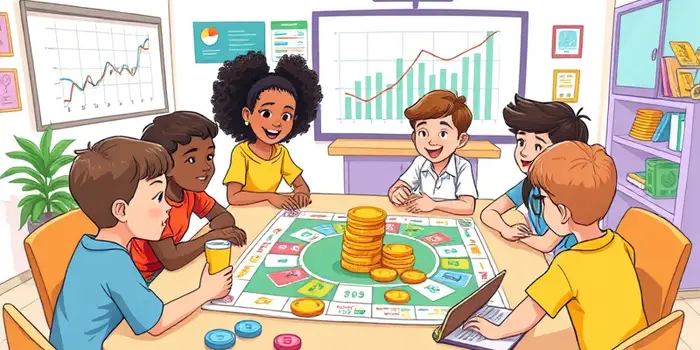Financial literacy empowers individuals to make informed decisions and achieve long-term stability. In today’s fast-paced world, understanding money management is no longer optional—it’s essential. By embracing engaging methods, learners of all ages can grasp complex concepts and apply them to real-life situations.
Innovative, interactive lessons transform abstract theories into tangible experiences. Instead of passively absorbing information, participants actively navigate budgeting challenges, investment simulations, and credit scenarios. This hands-on approach builds confidence and fosters a deeper understanding of financial systems.
The Importance of Financial Literacy
Financial literacy is the foundation for a lifetime of economic well-being. When individuals lack basic money management skills, they face higher risks of debt accumulation, poor credit scores, and inadequate retirement savings. Recent research shows that approximately 63% of Americans are financially illiterate, and only 24% of millennials demonstrate basic financial competence. These alarming figures highlight a growing need for effective education.
Poor financial knowledge can lead to costly mistakes, such as missing bill payments, falling prey to high-interest loans, or neglecting long-term investment opportunities. Conversely, those who master budgeting, saving, and debt management enjoy greater autonomy and reduced stress, enabling them to pursue personal and professional goals with confidence.
Core Concepts and Interactive Lessons
At the heart of interactive financial education are immersive activities that simulate real-world choices. These lessons invite learners to experiment, fail safely, and learn from consequences, making each experience memorable and impactful.
- Needs vs. Wants Exercise: Distribute tokens or beans to represent income. Participants allocate resources between necessities and luxuries, then face random “life events” to illustrate the importance of emergency funds.
- Credit Score Jenga: Modify a Jenga tower so each block represents credit behaviors. Removing blocks for late payments or high balances demonstrates how risky choices can destabilize one’s financial standing.
- Get a Life Simulation: In this digital game, players choose careers, manage budgets, and navigate expenses like housing and childcare. The dynamic platform shows long-term effects of financial decisions.
These activities emphasize tracking income and expenses and encourage critical thinking. By simulating emergencies, fluctuating incomes, and unexpected costs, learners develop adaptability and resilience.
Another popular online tool is The Stock Market Game, where participants invest virtual funds in real-world stocks. This risk-free environment teaches market dynamics, diversification, and the power of compound interest. Meanwhile, The Uber Game places players in the shoes of gig workers, balancing unpredictable earnings against daily obligations like rent and groceries.
Hands-On and Creative Classroom Methods
Beyond digital simulations, educators can harness creative techniques to reinforce concepts. Paper Bag Theater encourages students to stage skits about loan applications or insurance claims, solidifying understanding through performance. Matching Pairs Games challenge learners to connect financial terms with definitions or images, strengthening vocabulary and comprehension.
Creative projects, such as designing social media graphics on saving tips or composing raps about budgeting rules, make financial topics resonate with contemporary audiences. These collaborative exercises foster teamwork and communication skills, while ensuring the material sticks.
Tailoring Lessons to Different Audiences
Financial education must adapt to varied age groups and life stages. Younger students benefit from simplified games, while adults require deeper dives into investing and risk management. The following table outlines recommended focus areas and activities for each demographic:
Strategies for Effective Learning
To maximize engagement and retention, educators and program designers should:
Connect lessons to real-life scenarios by inviting guest speakers or sharing relatable anecdotes. When students hear firsthand experiences of managing loans or saving for major purchases, concepts become tangible.
Use formative assessments, such as in-the-moment quizzes or polling apps, to gauge understanding and address misconceptions immediately. This iterative feedback builds mastery and prevents confusion from accumulating.
Emphasize the value of reflection and recovery. Teaching learners to learn from setbacks and build resilience helps them rebound from mistakes, whether it’s an overspent budget or an unexpected expense.
Resources for Continued Growth
Even after structured lessons conclude, ongoing practice and exploration are key. A variety of free and reliable resources support learners at every stage:
- MyMoney.gov: Central portal with tools, worksheets, and planning calculators for budgeting, investing, and protecting assets.
- Investor.gov: Comprehensive guides on compound interest, retirement strategies, and market basics.
- CFPB Youth Financial Education: Classroom-ready modules and interactive exercises for grades K–12.
- Mint and YNAB Apps: User-friendly budgeting platforms that sync accounts, categorize spending, and set savings goals.
These platforms offer tools, worksheets and planning calculators designed to reinforce lessons and promote self-directed learning. By incorporating technology, learners can track progress, visualize goals, and adjust strategies in real time.
Conclusion
Financial literacy is a journey, not a destination. Interactive lessons—whether through games, simulations, or creative projects—ignite curiosity and encourage active participation. As learners engage with realistic scenarios, they gain the confidence and competence needed to navigate an increasingly complex financial landscape.
By integrating immersive activities, leveraging reliable resources, and tailoring content to diverse audiences, educators and mentors can transform financial education into an empowering adventure. Ultimately, the goal is simple: equip every individual with the knowledge and skills to build a secure, prosperous future.
References
- https://www.edutopia.org/article/7-teacher-tested-financial-literacy-lessons-that-pull-students-in/
- https://www.consumerfinance.gov/consumer-tools/educator-tools/youth-financial-education/teach/activities/
- https://nearpod.com/blog/college-savings-month-financial-literacy/
- https://www.fitzsimonscu.com/blog/financial-literacy-games-for-children-and-adults/
- https://www.edutopia.org/article/10-free-financial-literacy-games-high-school-students/
- https://www.annuity.org/financial-literacy/
- https://www.investopedia.com/terms/f/financial-literacy.asp










